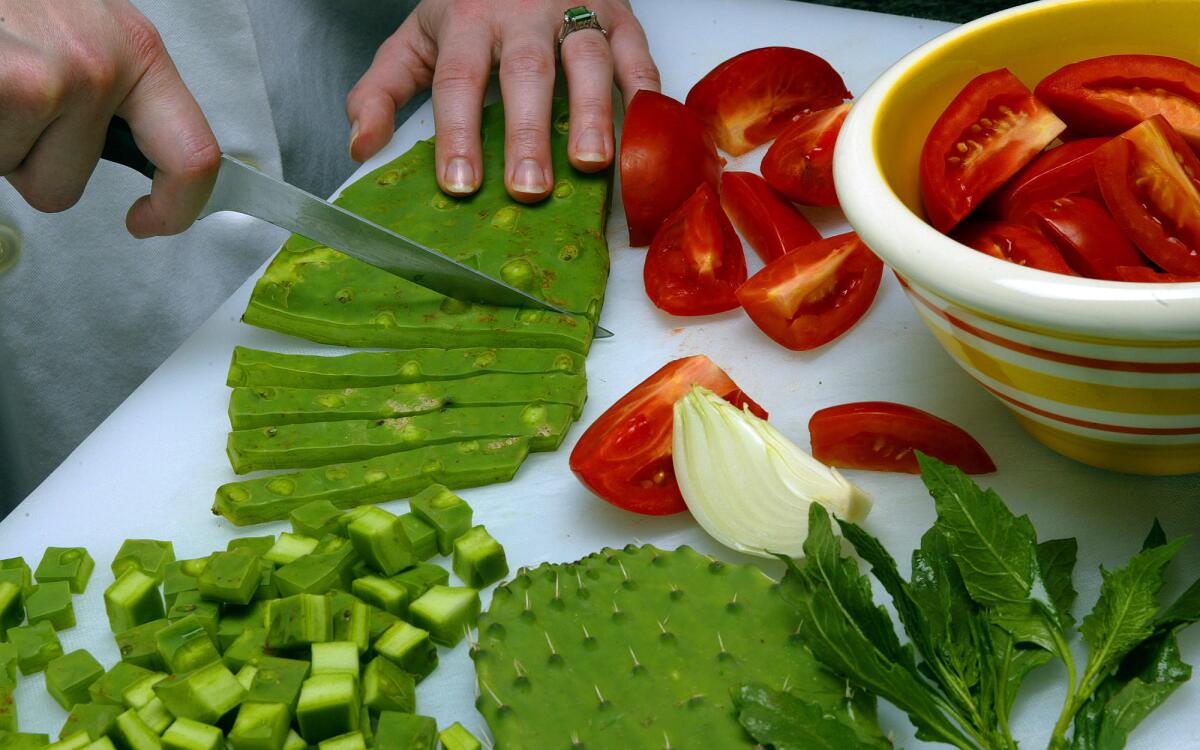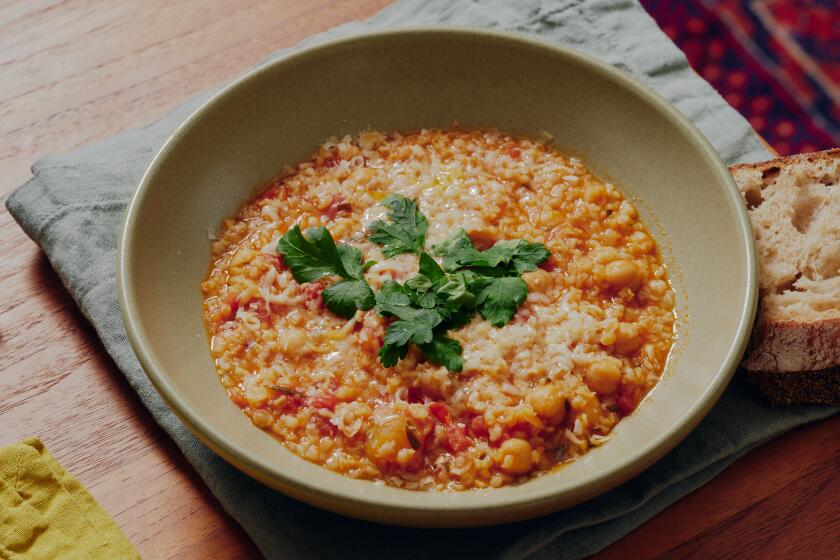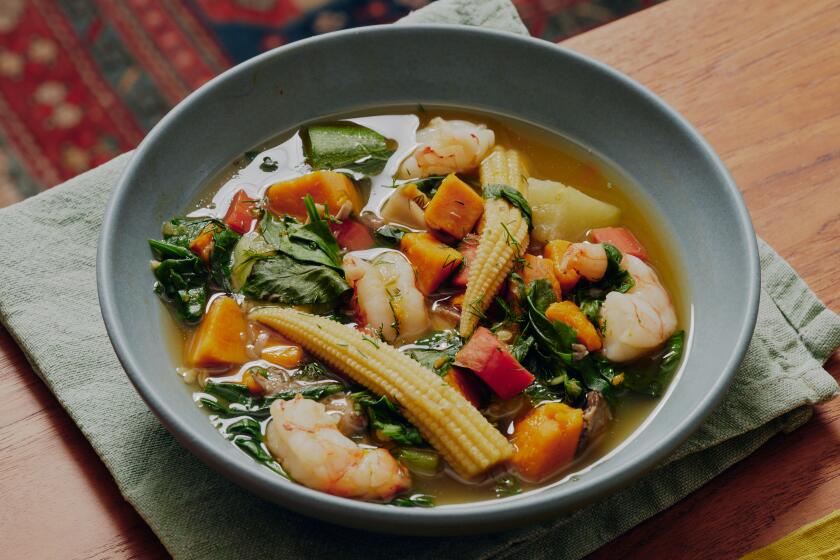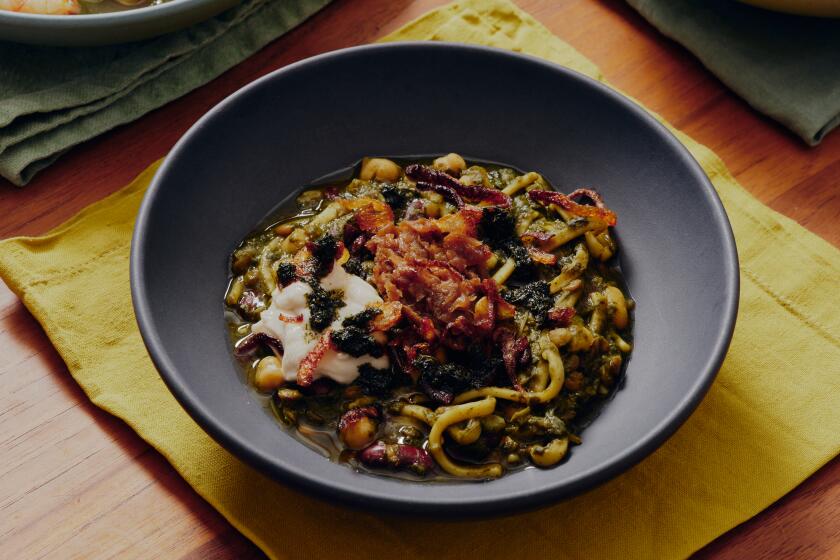Guisado de nopales (stewed cactus paddles)

Prickly desert cactus sounds like the last thing you’d want to eat. But -- surprise! -- once the spines are off, cactus is juicy and tender, great in anything from salads and soups to main courses and even desserts.
The variety we’re talking about is Mexico’s nopal cactus -- prickly pear. You may have seen it right here in town, growing wild or in someone’s backyard, a sprawling plant composed of oval “paddles.”
These are what you eat. They’re best when young, about the size of a hand or a little larger. Cut into strips and cooked, they look a bit like green beans. The flavor is delicate, not what you’d expect from a cantankerous-looking desert dweller.
For centuries, Mexicans have eaten nopales in everything from stews to salads and omelets. So embedded is the nopal cactus in Mexican culture that it appears on the flag and on coins. A cactus plant supporting an eagle holding a snake was, according to legend, the sign that led the Aztecs to found their capital, Tenochtitlan, on the site that is now Mexico City.
Mexican cooks love to get creative with nopales. On a recent visit to the little town of Santa Rosa near Guanajuato, I came across a nopal liqueur, made by a women’s co-op that has a shop on the main street. The women also make a sweet, firm paste, called ate, from cactus. It’s cut into chunks, to eat like candy. In a health food store I spotted nopal cookies, and in Mexican pharmacies I’ve seen nopal shampoo.
But that’s not all this plant can do. Beside the paddle, the nopal cactus produces a fruit that is small and seedy, but sweet and delicious. In Spanish it’s known as tuna, which naturally causes endless confusion among non-Spanish-speakers accustomed to tuna casseroles and tuna sandwiches. Imagine their shock at coming across an agua fresca (a sweet drink) or a paleta (a popsicle) -- made with tuna.
Here, nopales are in every Latino market, and sometimes they show up at farmers markets and well-stocked grocery stores. The paddles are sold whole, or you can find them cleaned of their spines, cut up and packaged.
When shopping, look for nopales that are small, tender and bright green rather than large, thick and faded. Avoid any that are flabby and soft. Some markets provide tongs for picking up paddles that still have their spines. But don’t worry if your market is tongless -- grab a plastic produce bag or two, and use them to shield your fingers.
Removing the spines is not difficult -- it just takes a sharp knife. Hold the paddle on a slant and slice downward, starting from the base, not the rounded top. Trim off the edge of each paddle, and discard the thick base. You can also try a sharp vegetable peeler, but you may have to go back with a paring knife to cut out some stubborn spines. As you work, grip the cactus with a potholder, dishcloth or thick glove.
Once you’ve mastered this procedure, you’re ready to experiment, or copy the way local Mexican restaurants treat nopales. Cooked nopales remain slightly firm and resilient, unlike vegetables that soften when boiled too long. They keep well if cooked in advance, which is handy if you want to scramble eggs with nopales for breakfast.
Tacos Clarita on East 4th Street in Los Angeles serves nopalitos asados (grilled nopales), topped with grilled onions and jalapeno strips. Guelaguetza in Koreatown ladles Oaxacan-style fajitas -- thin-cut salted beef known as tasajo, cooked with tomato, onion, bell pepper and Oaxacan string cheese -- over nopales. Teresitas in East Los Angeles simmers espinazo (pork spine) with cactus.
The nopal champion, though, is Mary Carmen Salas of La Parrilla restaurant in Boyle Heights. Salas has written a flier for customers that explains what nopales are and where they grow. And she uses the fresh cactus in a lot of dishes. “It’s healthy food,” she says in the flier.
The most unusual is huarachito Tizoc, a nopal sandwich filled with shrimp and covered with tomatillo salsa and cheese. The long oval nopal paddle resembles the sole of a huarache sandal, she says, explaining the name. Huarachitos also come filled with beef or chicken.
La Parrilla’s big meat and seafood combinations, called molcajetes, include nopales too. They’re named for the stone mortars in which they are served. Nopalitos, says Salas, is the proper word for cactus that is cut up and ready to eat. Her nopalitos a la Mexicana is cactus cooked with tomato, chile and onion.
The most popular cactus dish, found in markets all over Mexico, is cactus salad. A simple chopped mixture of nopales, tomato, onion and chile, it’s sometimes tossed with crumbled Mexican cheese and flavored with cilantro or oregano. It’s common in restaurants here too. Senor Fred in Sherman Oaks puts cactus salad on the plate with carne asada, but the most interesting cactus dish at that restaurant is chile verde, a pork stew with nopales. Chef Juan Carlos Leon simmers the nopales in water before combining them with the other stew ingredients.
Leon insists on fresh cactus. “The flavor [of the canned] would ruin the flavor of my food,” he says.
When fresh ones are so easy to find, why use anything but? And don’t let the spines scare you. Remember, you’re the one with the knife.
Bring a medium saucepan of water to a boil. Trim, clean and wash the cactus. Cut each paddle into half-inch squares. Drop the cactus pieces into the boiling water and cook for 5 minutes. Drain.
Trim the stem ends of the tomatoes and cut the tomatoes into quarters. Place them in a blender container with the onion and one-fourth cup water. Blend thoroughly.
Heat the olive oil in a saucepan. Add the tomato mixture, epazote, chicken base and salt. Bring to a boil and simmer, uncovered, 10 minutes.
Add the cactus squares and the remaining one-fourth cup water. Bring to a boil and simmer gently, uncovered, 5 minutes. If the sauce becomes too thick, thin with a little water.
Get our Cooking newsletter.
Your roundup of inspiring recipes and kitchen tricks.
You may occasionally receive promotional content from the Los Angeles Times.















